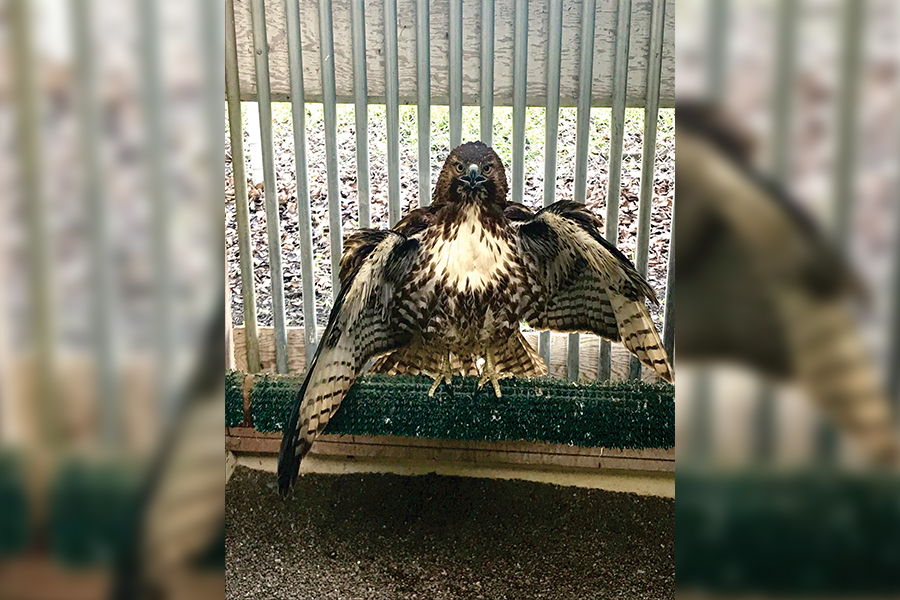
Raptor center cured, released red-tailed hawk whose feathers were broken
When a red-tailed hawk with six broken feathers was brought to the UC Davis-affiliated California Raptor Center, veterinarians knew they would need some old feathers and an old technique to heal the raptor. This method worked so well the hawk was able to be released back into the wild later that day.
Using old feathers that had been carefully stored and preserved, the center was able to imp the bird. Imping involves cutting away most of the broken feather on the bird, inserting a small wood rod in the hollow shaft of the feather, then attaching the preserved feather.
“Imping is actually a very old procedure, historically it dates back, some would say, hundreds, if not, potentially thousands of years along with the sport of falconry,” said Julie Cotton, the volunteer and outreach coordinator at the Raptor Center. “There are references to it in falconry manuals from the 1200s. So it’s a known procedure, it’s primarily associated with raptors, but in modern times it has been used in avian medicine with seabirds, parrots and other species as well.”
The materials for this procedure have changed over time, from wire and vinegar to wooden rods and epoxy. Although the idea behind the process sounds simple, the actual procedure is more difficult and very time-intensive.
“To prepare the feathers you must carve a small piece of bamboo that fits firmly into the shaft of the broken feather on the bird and also into the feather to be implanted on the bird’s broken feather,” said Bret Stedman, the operations supervisor. “This takes time to be sure it fits without splitting the feather shafts. When you have six feathers to prepare it does take a while to do it just right.
Stedman prepared the feathers himself. With the help of Michelle Hawkins, the director of the Raptor Center, Bill Ferrier, the former director, and veterinary residents, the feathers were attached to the raptor.
Even though birds molt their feathers, the imping procedure was deemed the best way to go. The rescuers wanted to get the raptor back into the wild as soon as possible and molting can take a long time, which meant the hawk might have had to stay in captivity from a few months to a year. Over time, the bird will replace all of its feathers, including the imped ones. This means that one day someone might find a red-tailed hawk feather on the ground that has been glued together.
“That’s exactly the idea behind the imping, that you’re giving the bird this temporary fix for the problem that should hold until it can naturally molt out the base of that old feather and grow in the new one,” Cotton said.
Since the hawk was able to fly well after the procedure, it was released on the same day. This is beneficial for the hawk as prolonged time in small spaces, such as carriers, increases the risk of the same feathers breaking again.
Imping is a known procedure, but not a very common one for the Raptor Center. Despite this, the Raptor Center holds onto feathers and stores them for the possibility of a future imping procedure.
“So we, at the Raptor Center, have a library of feathers from different raptors,” Cotton said. “And the feathers that are used in imping procedures very often come from […] carcasses maybe that people find or birds that have passed away. Because when you imp a bird you need to match not only the species of the bird correctly, but you have to match the age of the bird, get the right sized feathers, get the feathers from the correct wing or correct side of the tail. So it really does matter to have this library where everything is labeled, numbered and ordered.”
The Raptor Center rescues over 200 hawks each year. The goal of the volunteers is to be able to release the birds back into the wild after they have been healed. Birds that cannot be released often become a part of the center’s ambassador collection and are used to help teach others about raptors. Students can take advantage of this opportunity to learn more about raptors by visiting the Raptor Center. The center is open for most of the year and visitors can see other red-tailed hawks that are a part of its ambassador collection.
Birds that can be released are banded with an identification number and a phone number. This is so if the bird is found again, the success rates of the procedures the center has done on raptors can be tracked. Unfortunately, the data pool for this is small. According to Stedman, about four per 100 banded birds are ever found again.
With enough time, a pattern of success rates emerges. Stedman says he has a pretty good idea what works for the raptors the center rescues. Making sure the hawks live long lives after they are released again is crucial for they are a very important part of the natural order.
“Raptors are the birds that are highest on the food chain, and thus when their numbers decline it is very concerning that something quite devastating could be occurring in their environment to cause it,” Hawkins said. “They are environmental ambassadors in many ways, and by protecting them we protect the environment we all share. And they’re the world’s best rodent control.”
Written by: Rachel Paul — science@theaggie.org




